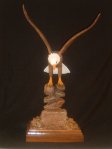*Bald Eagle Sightings
Click the link above to see a photo of our most recent wood-carving of the Bald Eagle. It is 2/5 scale (32″ wing-spread).
So, to get back onto “topic”; I recall that my personal first sighting of a Bald Eagle was in the 70s in Loveland, Ohio driving in a convertible with the whole family, with the top-down(we’ve had seven of them) in a wooded rural area. “Something” about 15-20 feet from the ground, in a tree at the edge of a field, caught the corner of my eye. It caused me to stop and turn my head to see what it was. The family was a-bit shaken at my driving and I told them to look at the Bald Eagle watching us from the tree. They saw it as it leaned, then flew low, then high across the field and away. It was stunning.
Once again, in Loveland, Ohio in the 70s, early in the morning, I was sitting on the front stoop of a friend’s house on Fallis Road, waiting for him to come-out to go play golf. There were woods most everywhere around his lovely ranch home. A Bald Eagle came from behind his home, low over his house and precisely over my head and into the woods across the road. I read later in the town newspaper that an Eagle’s nest had been seen in the woods along Fallis Road.
Over the years since then, we’ve had our share of Bald Eagle sightings in Florida and in Kentucky, as well.
A year or two ago, I saw a Bald Eagle fly directly across the Social Row Road, a mile from our home, here in Centerville, Ohio. I’ve seen them fly over our house as well.
Yesterday, we were at “Scrambler’s” after church having lunch with friends. We were at a table facing out of the large window and across the street and the field beyond. I was facing in that direction while we were all talking. My eye doesn’t tend to miss much of anything to do with “birds”. I saw what I knew to be a Bald Eagle, just over 100 yards from where I was observing. It was flying (not soaring on the thermals) to and fro and not very high. I first determined that the wing-to-body-angles (dihedrals) were not a TV (Turkey Vulture) and that it’s “wing-flap” was not the 3-flaps & glide of a hawk. Then, on it’s turn, I glimpsed the white of the tail and head. A Bald Eagle. So, I mentioned it to my friends. The man with us said, “I’m an old briar and that’s not an Eagle”. His wife, who sat facing me, countered that she had also been watching the bird, over my shoulder in the reflection of the glass panel behind my seat. She said the she “knew it to be a Bald Eagle too” because she had also “glimpsed the white”. I simply said that I knew that he was a briar and also that the bird was an Eagle. He bought our lunch so, I guess the point was taken.
I look forward to recording the above in my brand-new Nature Source Bird Field Guide App on my NOOK Tablet. Re: My Previous Posting on Field Guides It features Life Lists that have “sightings” data entry. Bald Eagles are worth my time. You see, the wood-carving has led me irretrievably to this other hobby, “Bird Watching”.
Happy birding and carving, Bill


























